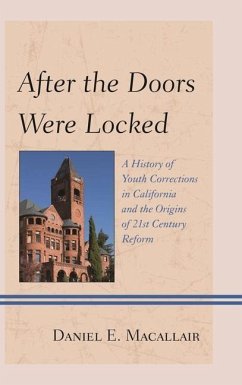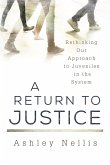Daniel E Macallair
After the Doors Were Locked
A History of Youth Corrections in California and the Origins of Twenty-First Century Reform
Daniel E Macallair
After the Doors Were Locked
A History of Youth Corrections in California and the Origins of Twenty-First Century Reform
- Broschiertes Buch
- Merkliste
- Auf die Merkliste
- Bewerten Bewerten
- Teilen
- Produkt teilen
- Produkterinnerung
- Produkterinnerung
After the Doors Were Locked offers a look at the history of youth corrections in California from its origins to the present day. Macallair comments on the practices and how they have evolved throughout the centuries. This book also looks at the reforms currently taking place in California prison systems today.
Andere Kunden interessierten sich auch für
![Criminal Law Criminal Law]() Jonathan HerringCriminal Law32,99 €
Jonathan HerringCriminal Law32,99 €![Boy with a Knife: A Story of Murder, Remorse, and a Prisoner's Fight for Justice Boy with a Knife: A Story of Murder, Remorse, and a Prisoner's Fight for Justice]() Jean TrounstineBoy with a Knife: A Story of Murder, Remorse, and a Prisoner's Fight for Justice15,99 €
Jean TrounstineBoy with a Knife: A Story of Murder, Remorse, and a Prisoner's Fight for Justice15,99 €![A Return to Justice A Return to Justice]() Ashley NellisA Return to Justice39,99 €
Ashley NellisA Return to Justice39,99 €![Youth and the Law Youth and the Law]() Daniel J BaumYouth and the Law13,99 €
Daniel J BaumYouth and the Law13,99 €![A Backward Glance at Eighty A Backward Glance at Eighty]() Charles A. MurdockA Backward Glance at Eighty14,99 €
Charles A. MurdockA Backward Glance at Eighty14,99 €![The Sins Of Cyntoia Brown: A Johnny Allen PostScript The Sins Of Cyntoia Brown: A Johnny Allen PostScript]() Walt TrottThe Sins Of Cyntoia Brown: A Johnny Allen PostScript21,99 €
Walt TrottThe Sins Of Cyntoia Brown: A Johnny Allen PostScript21,99 €![In the Spider's Web In the Spider's Web]() Jerome GoldIn the Spider's Web13,99 €
Jerome GoldIn the Spider's Web13,99 €-
-
-
After the Doors Were Locked offers a look at the history of youth corrections in California from its origins to the present day. Macallair comments on the practices and how they have evolved throughout the centuries. This book also looks at the reforms currently taking place in California prison systems today.
Hinweis: Dieser Artikel kann nur an eine deutsche Lieferadresse ausgeliefert werden.
Hinweis: Dieser Artikel kann nur an eine deutsche Lieferadresse ausgeliefert werden.
Produktdetails
- Produktdetails
- Verlag: Rowman & Littlefield Publishers
- Seitenzahl: 350
- Erscheinungstermin: 6. November 2017
- Englisch
- Abmessung: 230mm x 151mm x 26mm
- Gewicht: 522g
- ISBN-13: 9780810894945
- ISBN-10: 0810894947
- Artikelnr.: 49444102
- Verlag: Rowman & Littlefield Publishers
- Seitenzahl: 350
- Erscheinungstermin: 6. November 2017
- Englisch
- Abmessung: 230mm x 151mm x 26mm
- Gewicht: 522g
- ISBN-13: 9780810894945
- ISBN-10: 0810894947
- Artikelnr.: 49444102
Daniel E. Macallair is the Executive Director and co-founder of the Center on Juvenile and Criminal Justice. Macallair's expertise is in the development and analysis of youth and adult correctional policy. He has implemented model community corrections programs and incarceration alternatives throughout the country and is an expert on criminal justice reform. Macallair serves on the faculty of the Department of Criminal Justice Studies at San Francisco State University as a Practitioner-in-Residence, where he teaches courses on adult and juvenile corrections policy. He is also an author of numerous publications and an invited speaker at conferences and seminars throughout the country.
Foreword: Honorable Tom Ammiano, Former Chair, Assembly Public Safety
Committee California State Legislature Preface: Tim Silard, President,
Rosenberg Foundation Acknowledgments Introduction: Juvenile Justice in
Historical Perspective by Randall G. Shelden PART I: THE SAN FRANCISCO
INDUSTRIAL SCHOOL AND THE ORIGINS OF YOUTH CORRECTIONS IN CALIFORNIA 1 The
Industrial School's Historical Roots 2 The Founding of the San Francisco
Industrial School 3 Reorganization and Reform 4 New Legal Procedures and
Jurisprudence 5 New Approaches and the Birth of Probation 6 The Industrial
School's Legacy PART II: CALIFORNIA ENTERS THE REFORM SCHOOL ERA 7 The
California State Penological Commission and the Search for New Approaches 8
Founding of the California Juvenile Court 9 The Whittier State School and
the Realities of Institutional Life 10 The Introduction of Intelligence
Testing at Whittier and the Emergence of Eugenics 11 Preston and the George
Junior Republic Experiment 12 The Establishment of the California School
for Girls 13 Preston in the 1920s and 1930s 14 California Commission on the
Study of Problem Children and the Reaffirmation of Institutional Care 15
The 1930s: The Decade of Complacency and the End of an Era PART III: FROM
REFORM SCHOOL TO CORRECTIONAL SYSTEM: THE CREATION OF THE CALIFORNIA YOUTH
AUTHORITY 16 The Death of Benny Moreno 17 The Death of Edward Leiva and the
Lindsey Committee 18 The Lindsey Report: Pulling Back the Curtain on
Institutional Care 19 The Birth of the California Youth Corrections
Authority Act 20 Expansion into the 1950s 21 The Birth of Community
Treatment PART IV: THE YOUTH AUTHORITY'S DECLINE AND FALL 22 Changing
Politics of the 1970s and 1980s 23 The Path toward More Punitive Justice 24
The Commonweal Hearings 25 The Farrell Litigation and the End of the Youth
Authority Era 26 Returning to the Past: Reviving the Doctrine of
Institutional Care PART V: CONCLUSION Afterword: Chet P. Hewitt, President
& CEO, Sierra Health Foundation
Committee California State Legislature Preface: Tim Silard, President,
Rosenberg Foundation Acknowledgments Introduction: Juvenile Justice in
Historical Perspective by Randall G. Shelden PART I: THE SAN FRANCISCO
INDUSTRIAL SCHOOL AND THE ORIGINS OF YOUTH CORRECTIONS IN CALIFORNIA 1 The
Industrial School's Historical Roots 2 The Founding of the San Francisco
Industrial School 3 Reorganization and Reform 4 New Legal Procedures and
Jurisprudence 5 New Approaches and the Birth of Probation 6 The Industrial
School's Legacy PART II: CALIFORNIA ENTERS THE REFORM SCHOOL ERA 7 The
California State Penological Commission and the Search for New Approaches 8
Founding of the California Juvenile Court 9 The Whittier State School and
the Realities of Institutional Life 10 The Introduction of Intelligence
Testing at Whittier and the Emergence of Eugenics 11 Preston and the George
Junior Republic Experiment 12 The Establishment of the California School
for Girls 13 Preston in the 1920s and 1930s 14 California Commission on the
Study of Problem Children and the Reaffirmation of Institutional Care 15
The 1930s: The Decade of Complacency and the End of an Era PART III: FROM
REFORM SCHOOL TO CORRECTIONAL SYSTEM: THE CREATION OF THE CALIFORNIA YOUTH
AUTHORITY 16 The Death of Benny Moreno 17 The Death of Edward Leiva and the
Lindsey Committee 18 The Lindsey Report: Pulling Back the Curtain on
Institutional Care 19 The Birth of the California Youth Corrections
Authority Act 20 Expansion into the 1950s 21 The Birth of Community
Treatment PART IV: THE YOUTH AUTHORITY'S DECLINE AND FALL 22 Changing
Politics of the 1970s and 1980s 23 The Path toward More Punitive Justice 24
The Commonweal Hearings 25 The Farrell Litigation and the End of the Youth
Authority Era 26 Returning to the Past: Reviving the Doctrine of
Institutional Care PART V: CONCLUSION Afterword: Chet P. Hewitt, President
& CEO, Sierra Health Foundation
Foreword: Honorable Tom Ammiano, Former Chair, Assembly Public Safety
Committee California State Legislature Preface: Tim Silard, President,
Rosenberg Foundation Acknowledgments Introduction: Juvenile Justice in
Historical Perspective by Randall G. Shelden PART I: THE SAN FRANCISCO
INDUSTRIAL SCHOOL AND THE ORIGINS OF YOUTH CORRECTIONS IN CALIFORNIA 1 The
Industrial School's Historical Roots 2 The Founding of the San Francisco
Industrial School 3 Reorganization and Reform 4 New Legal Procedures and
Jurisprudence 5 New Approaches and the Birth of Probation 6 The Industrial
School's Legacy PART II: CALIFORNIA ENTERS THE REFORM SCHOOL ERA 7 The
California State Penological Commission and the Search for New Approaches 8
Founding of the California Juvenile Court 9 The Whittier State School and
the Realities of Institutional Life 10 The Introduction of Intelligence
Testing at Whittier and the Emergence of Eugenics 11 Preston and the George
Junior Republic Experiment 12 The Establishment of the California School
for Girls 13 Preston in the 1920s and 1930s 14 California Commission on the
Study of Problem Children and the Reaffirmation of Institutional Care 15
The 1930s: The Decade of Complacency and the End of an Era PART III: FROM
REFORM SCHOOL TO CORRECTIONAL SYSTEM: THE CREATION OF THE CALIFORNIA YOUTH
AUTHORITY 16 The Death of Benny Moreno 17 The Death of Edward Leiva and the
Lindsey Committee 18 The Lindsey Report: Pulling Back the Curtain on
Institutional Care 19 The Birth of the California Youth Corrections
Authority Act 20 Expansion into the 1950s 21 The Birth of Community
Treatment PART IV: THE YOUTH AUTHORITY'S DECLINE AND FALL 22 Changing
Politics of the 1970s and 1980s 23 The Path toward More Punitive Justice 24
The Commonweal Hearings 25 The Farrell Litigation and the End of the Youth
Authority Era 26 Returning to the Past: Reviving the Doctrine of
Institutional Care PART V: CONCLUSION Afterword: Chet P. Hewitt, President
& CEO, Sierra Health Foundation
Committee California State Legislature Preface: Tim Silard, President,
Rosenberg Foundation Acknowledgments Introduction: Juvenile Justice in
Historical Perspective by Randall G. Shelden PART I: THE SAN FRANCISCO
INDUSTRIAL SCHOOL AND THE ORIGINS OF YOUTH CORRECTIONS IN CALIFORNIA 1 The
Industrial School's Historical Roots 2 The Founding of the San Francisco
Industrial School 3 Reorganization and Reform 4 New Legal Procedures and
Jurisprudence 5 New Approaches and the Birth of Probation 6 The Industrial
School's Legacy PART II: CALIFORNIA ENTERS THE REFORM SCHOOL ERA 7 The
California State Penological Commission and the Search for New Approaches 8
Founding of the California Juvenile Court 9 The Whittier State School and
the Realities of Institutional Life 10 The Introduction of Intelligence
Testing at Whittier and the Emergence of Eugenics 11 Preston and the George
Junior Republic Experiment 12 The Establishment of the California School
for Girls 13 Preston in the 1920s and 1930s 14 California Commission on the
Study of Problem Children and the Reaffirmation of Institutional Care 15
The 1930s: The Decade of Complacency and the End of an Era PART III: FROM
REFORM SCHOOL TO CORRECTIONAL SYSTEM: THE CREATION OF THE CALIFORNIA YOUTH
AUTHORITY 16 The Death of Benny Moreno 17 The Death of Edward Leiva and the
Lindsey Committee 18 The Lindsey Report: Pulling Back the Curtain on
Institutional Care 19 The Birth of the California Youth Corrections
Authority Act 20 Expansion into the 1950s 21 The Birth of Community
Treatment PART IV: THE YOUTH AUTHORITY'S DECLINE AND FALL 22 Changing
Politics of the 1970s and 1980s 23 The Path toward More Punitive Justice 24
The Commonweal Hearings 25 The Farrell Litigation and the End of the Youth
Authority Era 26 Returning to the Past: Reviving the Doctrine of
Institutional Care PART V: CONCLUSION Afterword: Chet P. Hewitt, President
& CEO, Sierra Health Foundation







